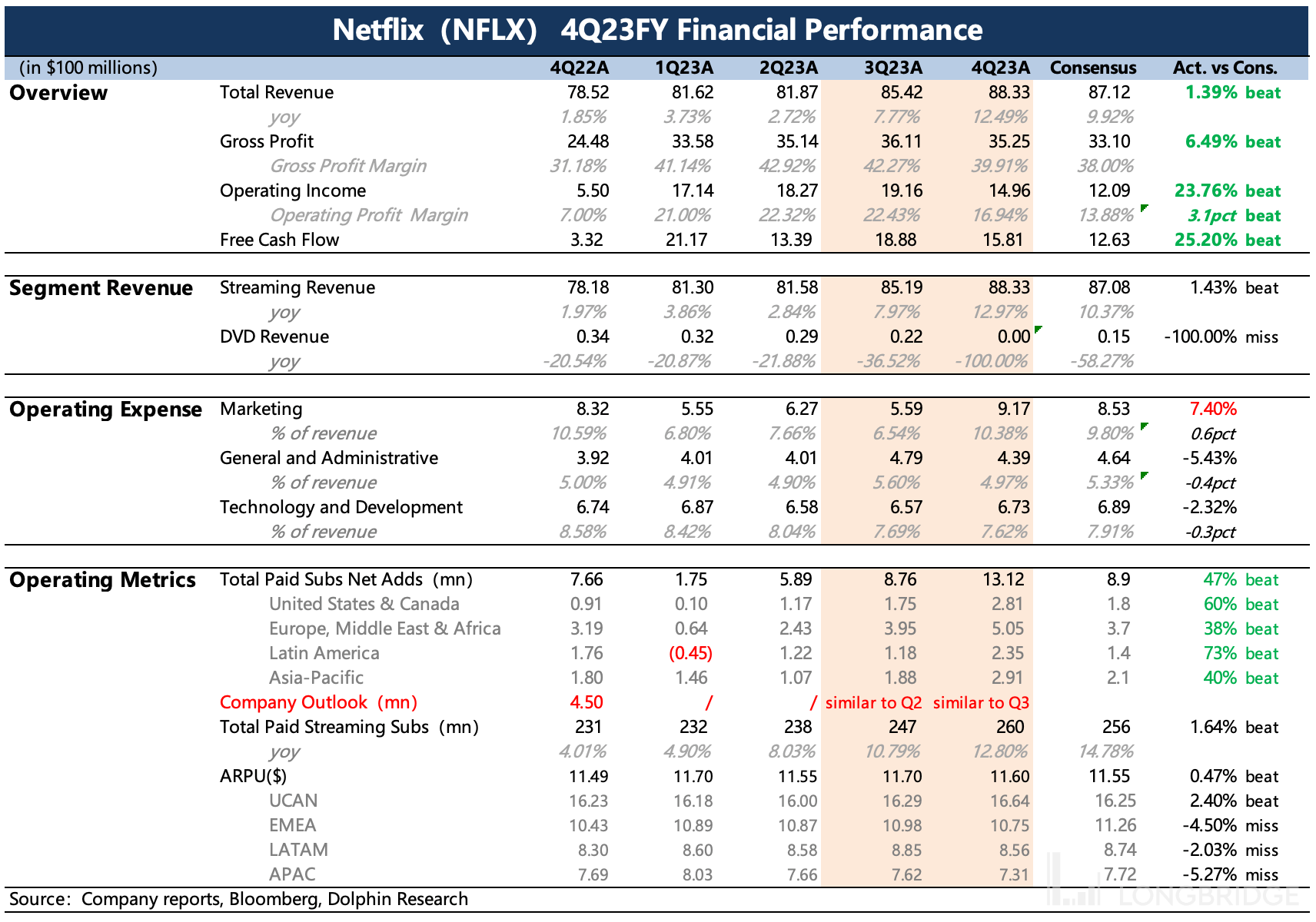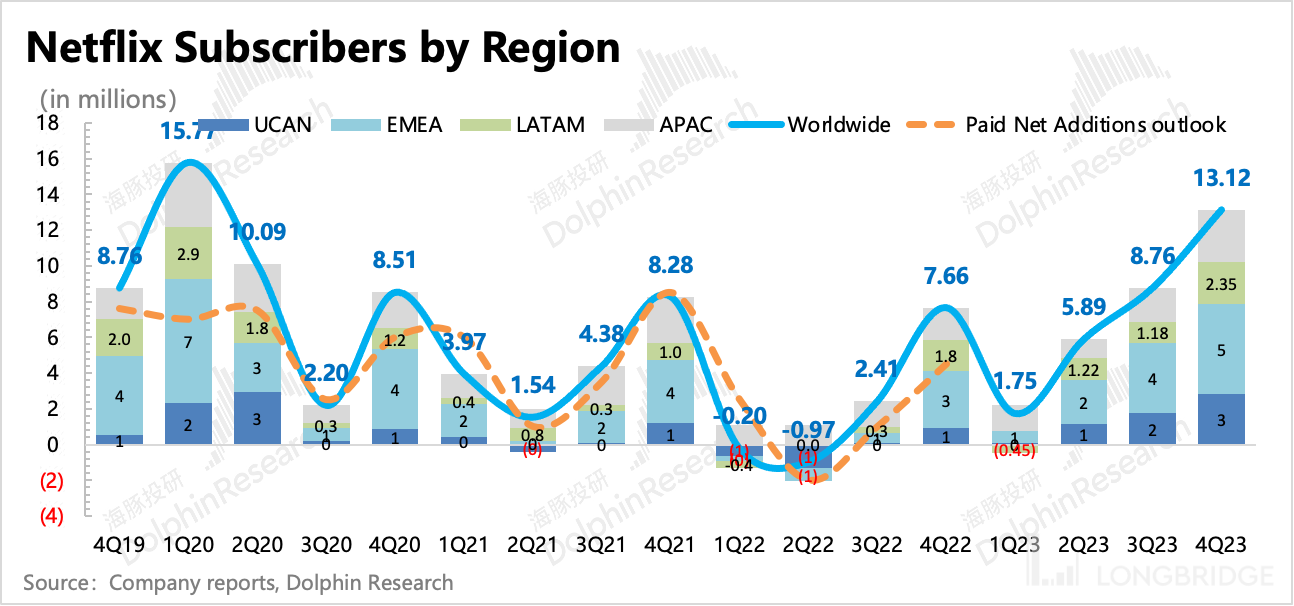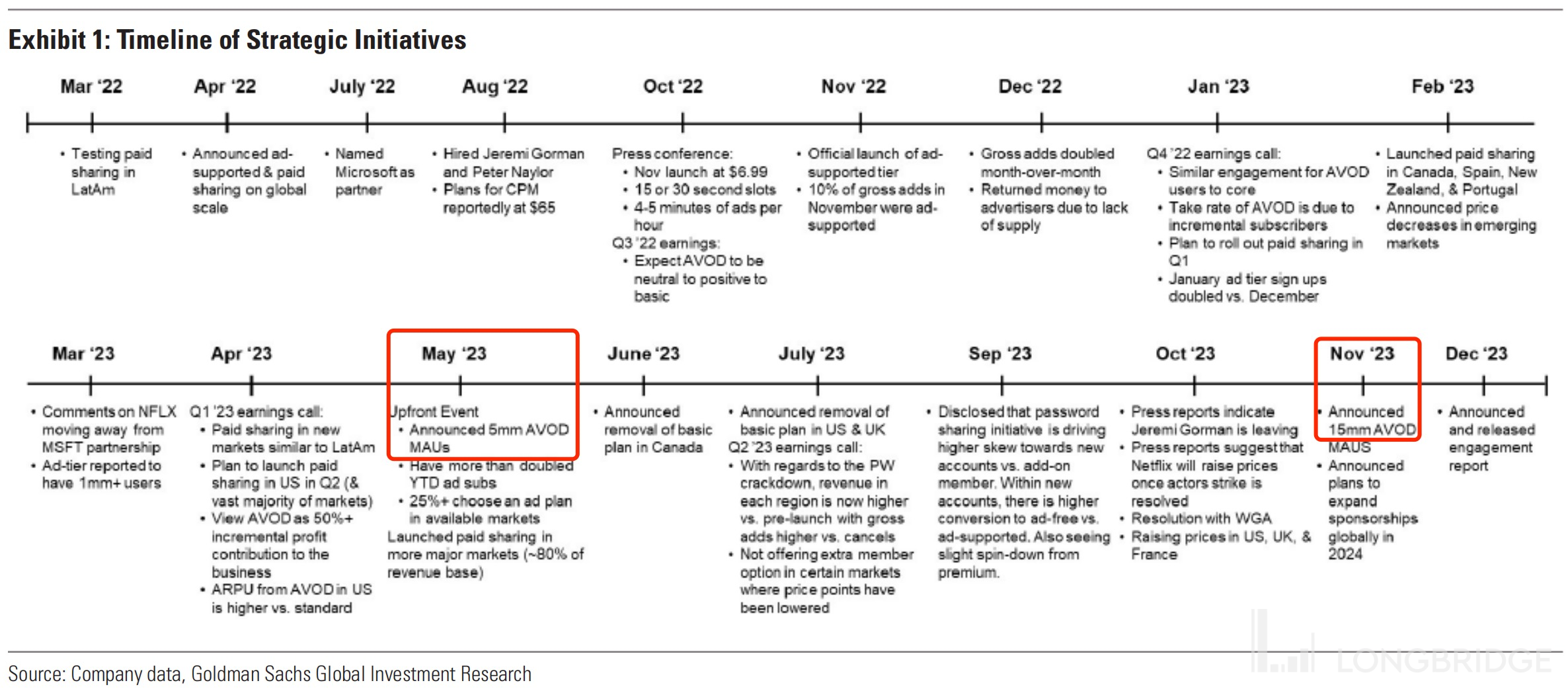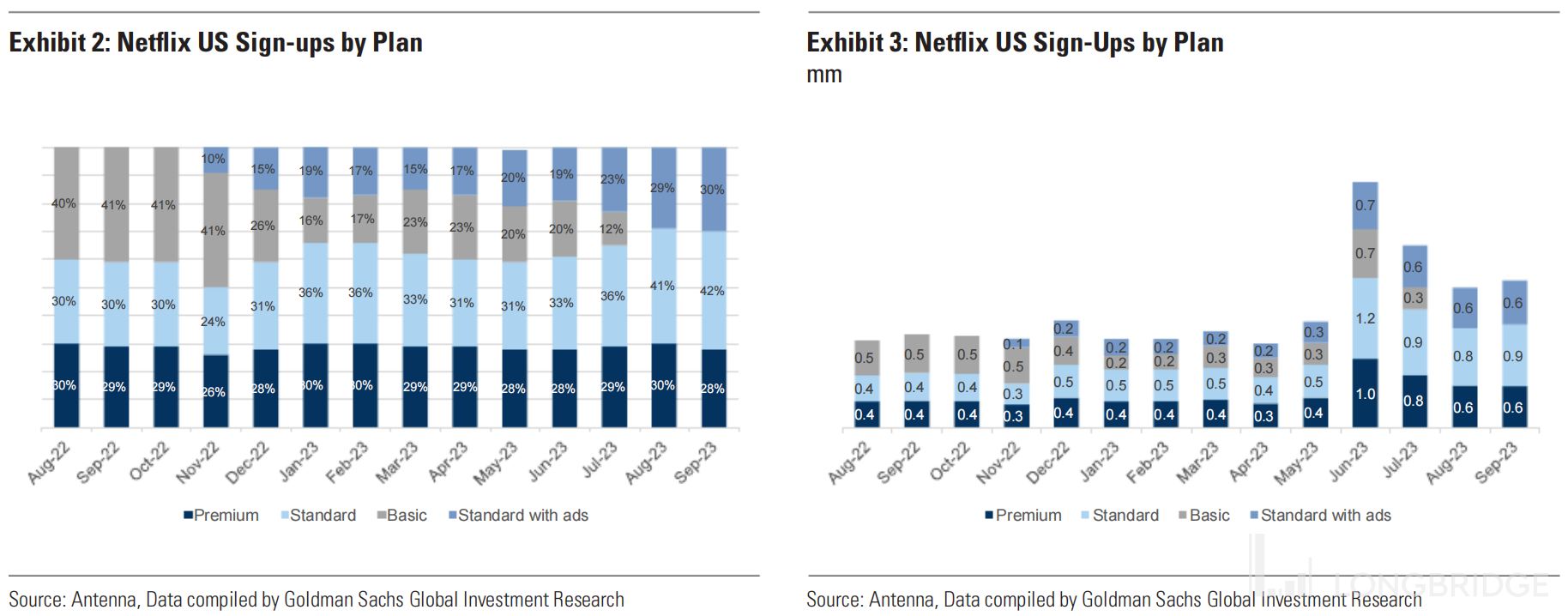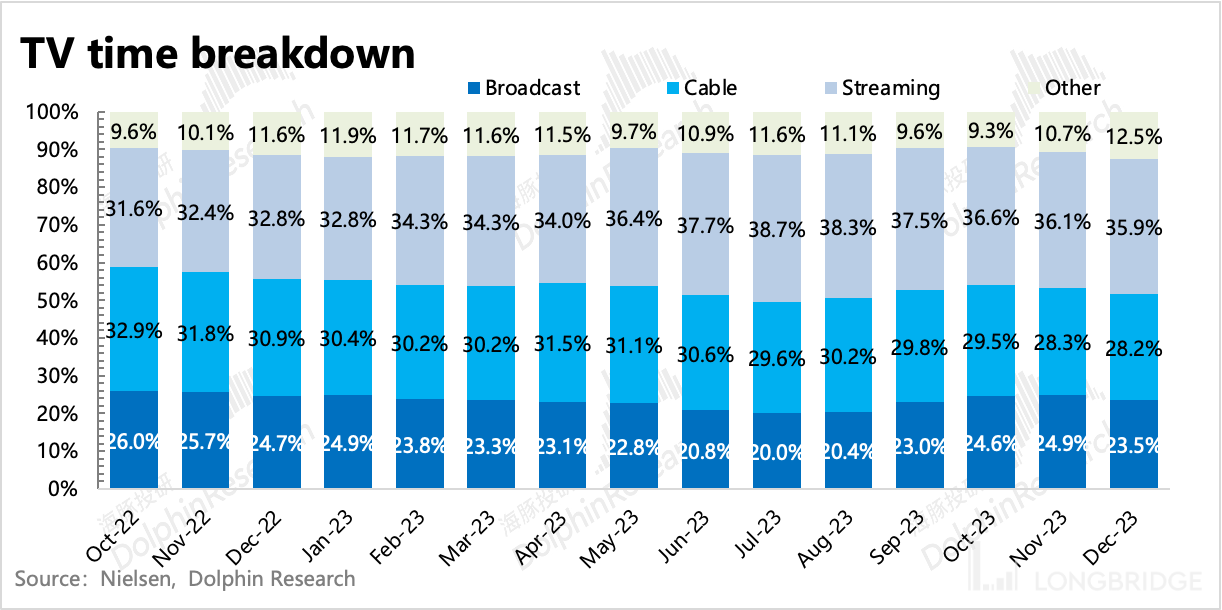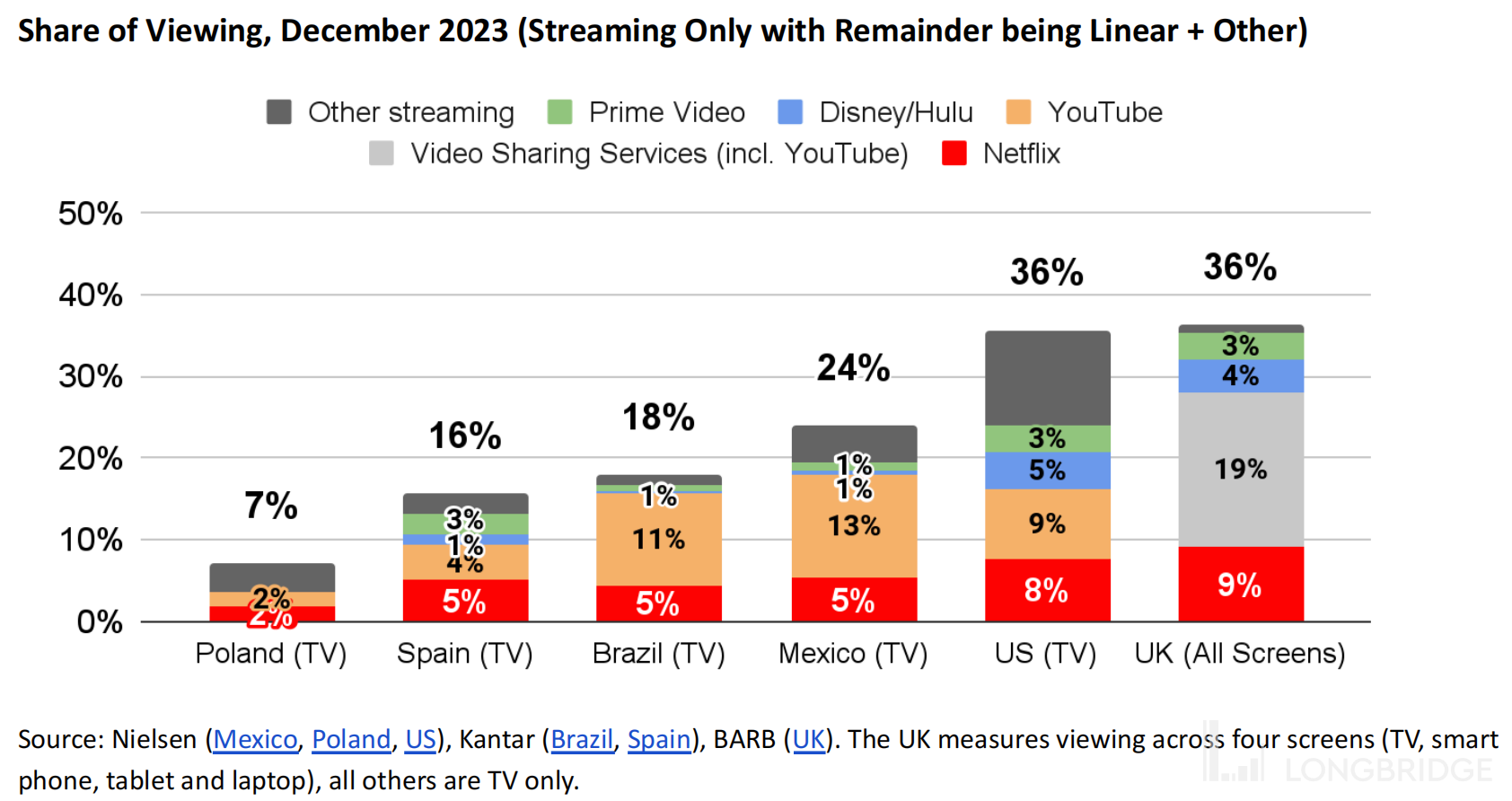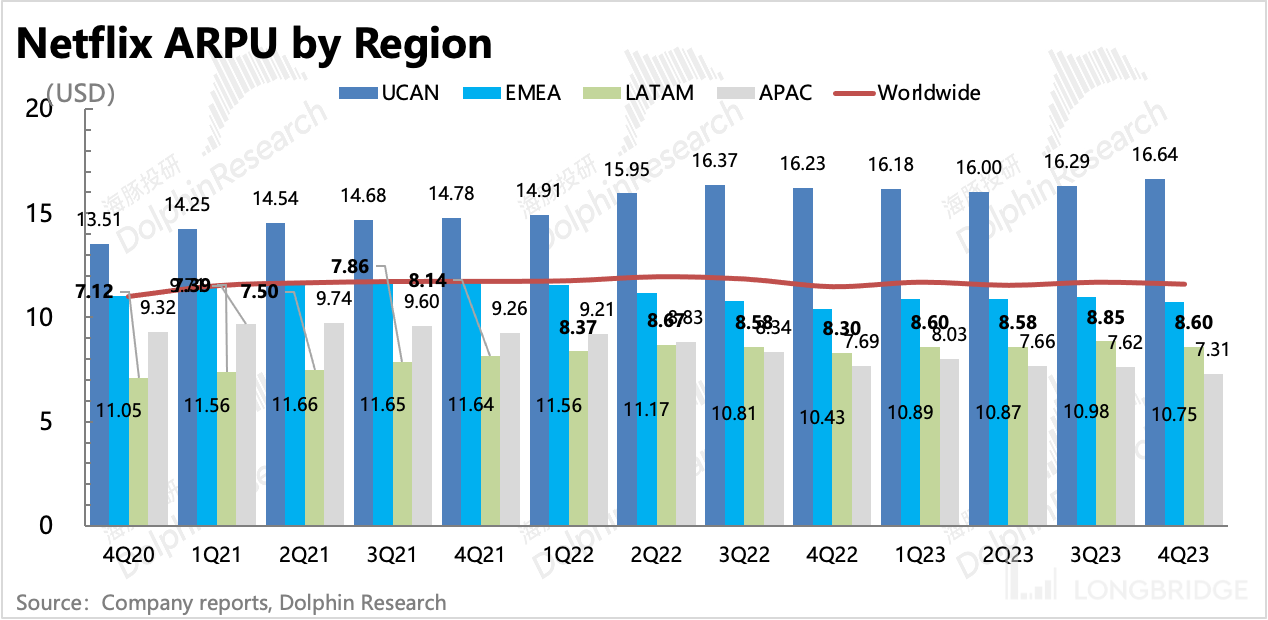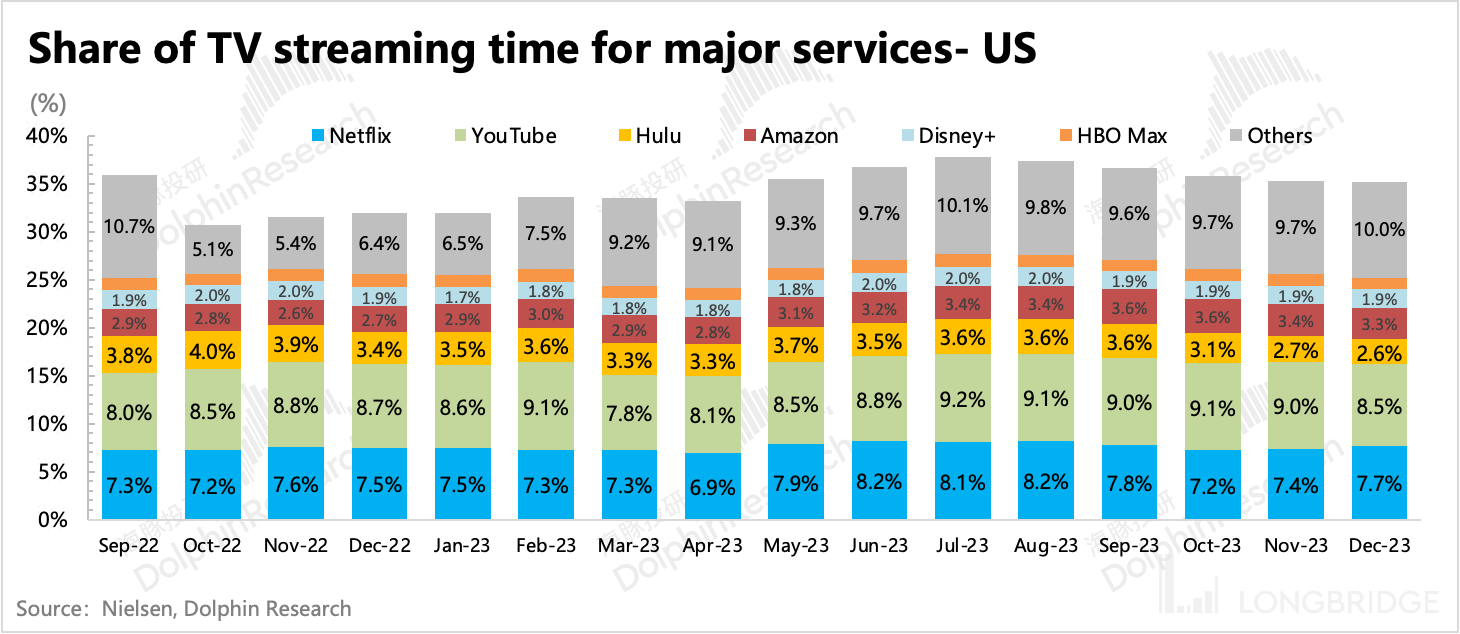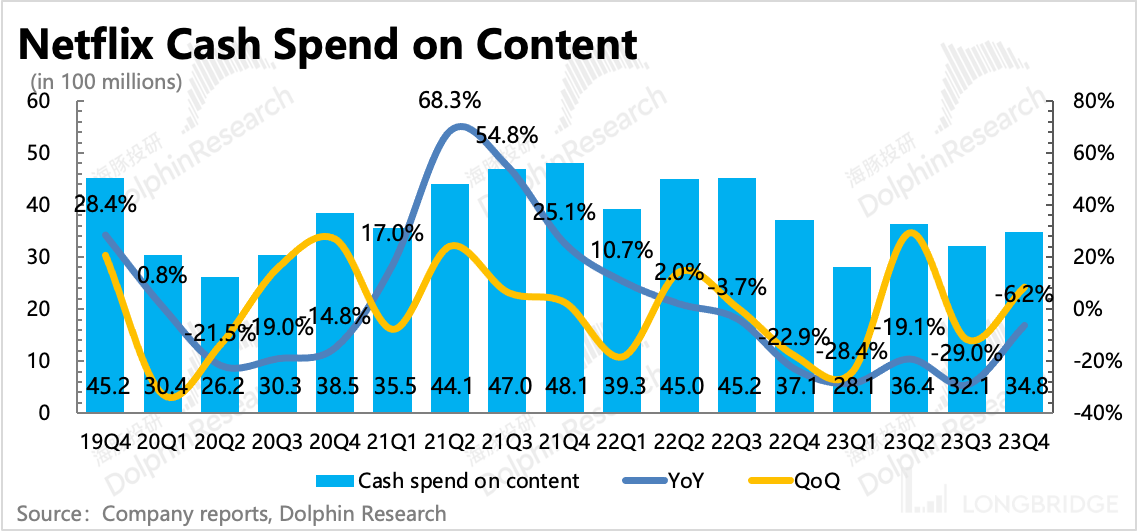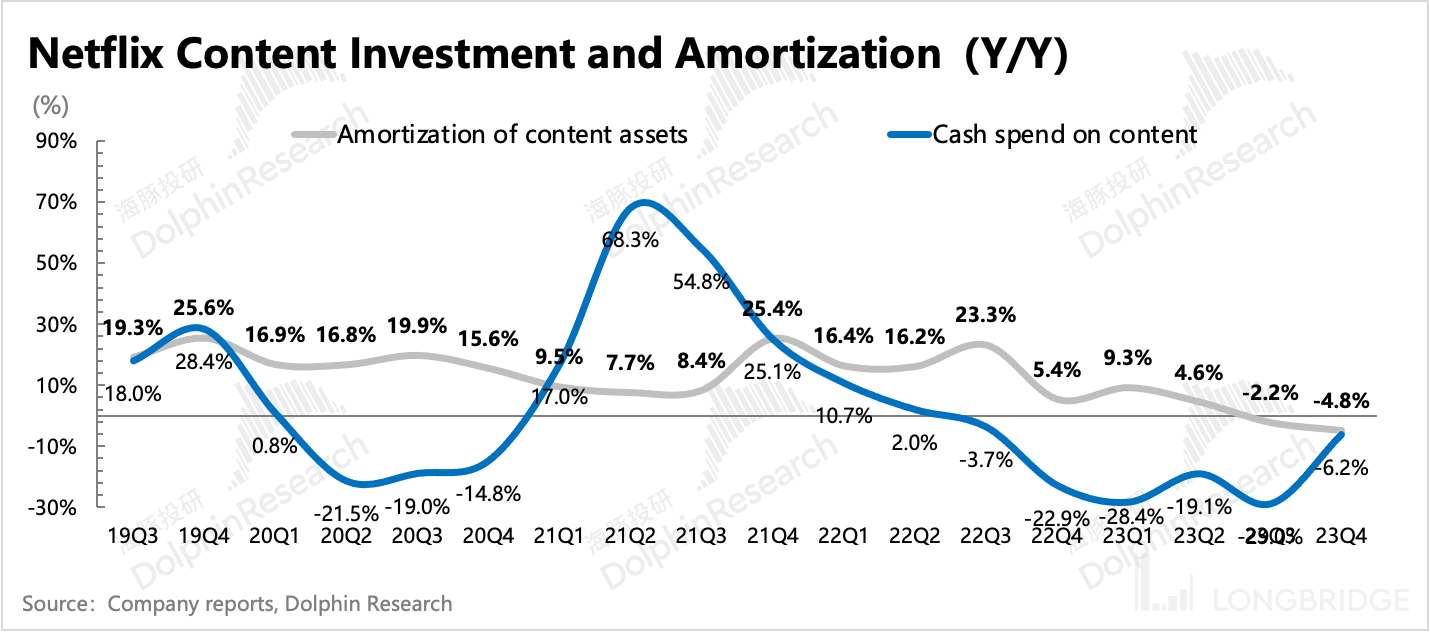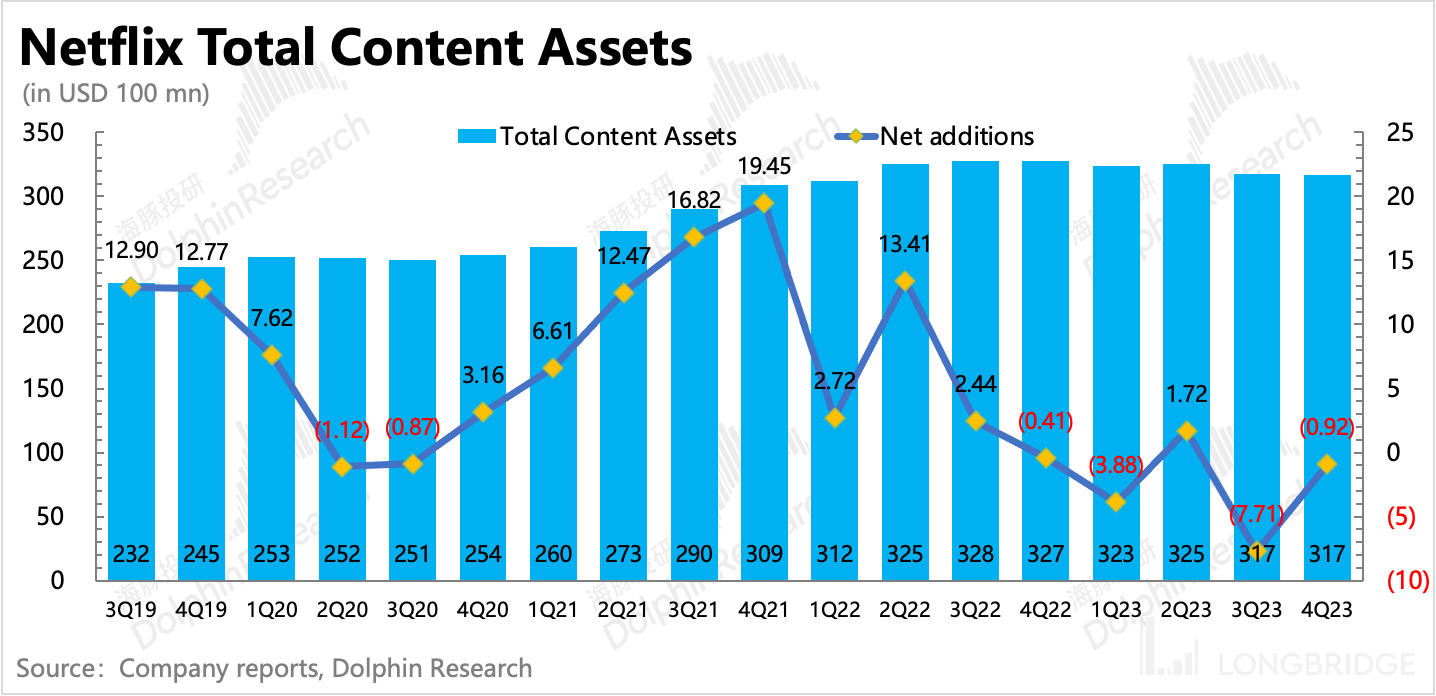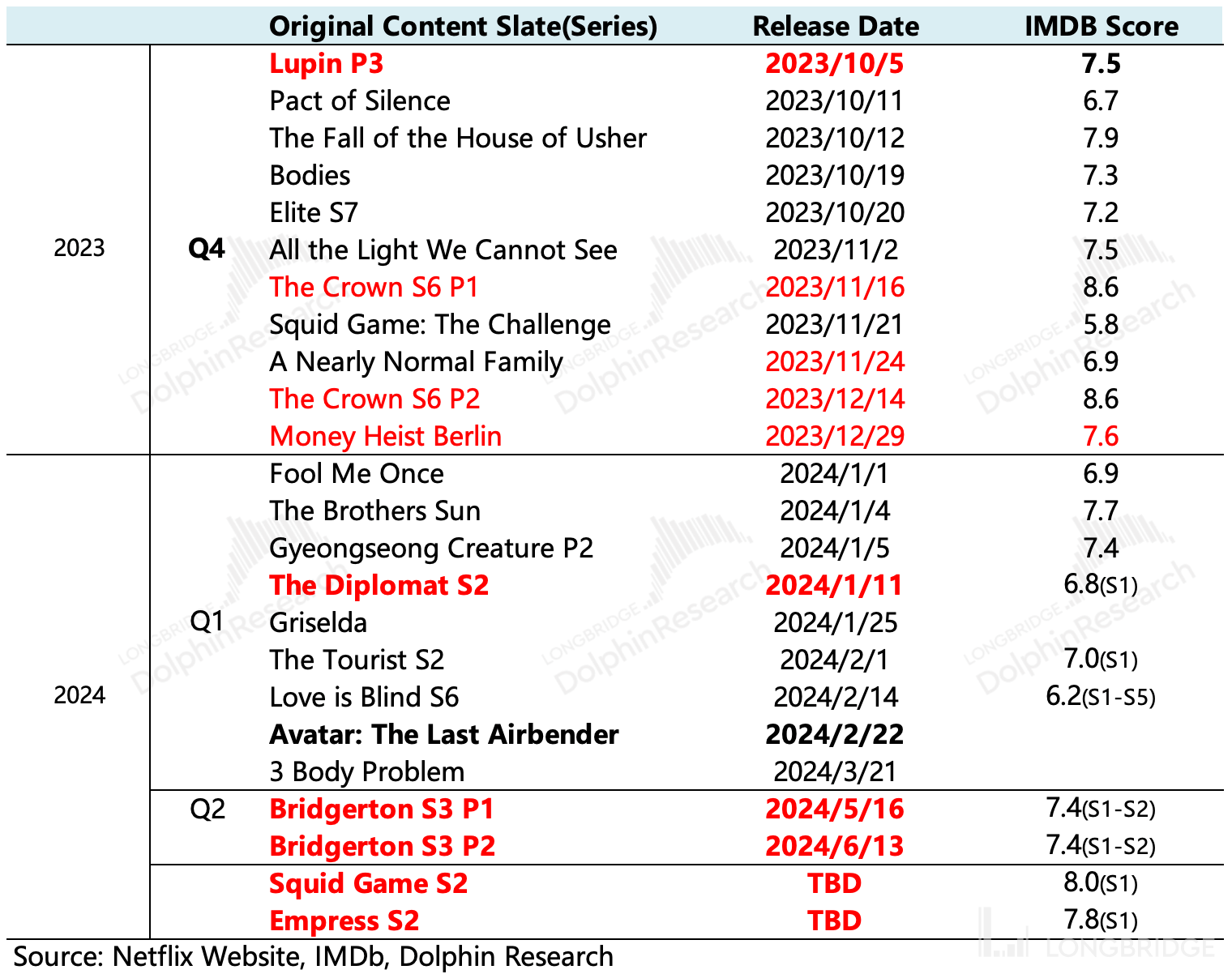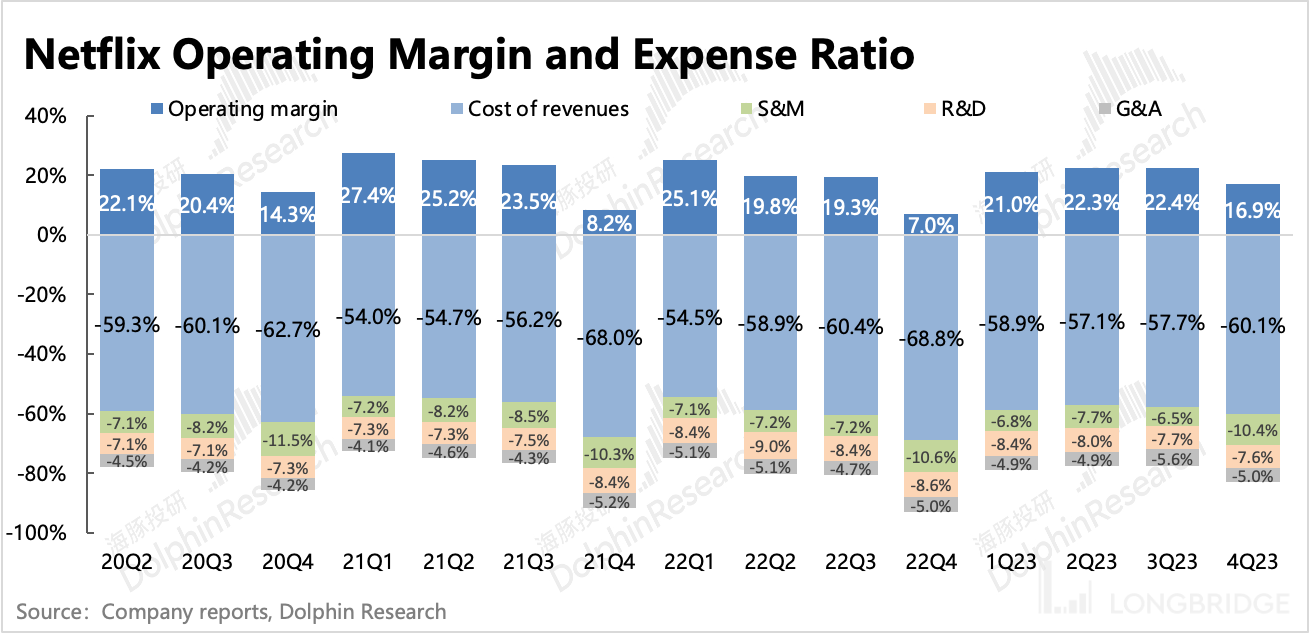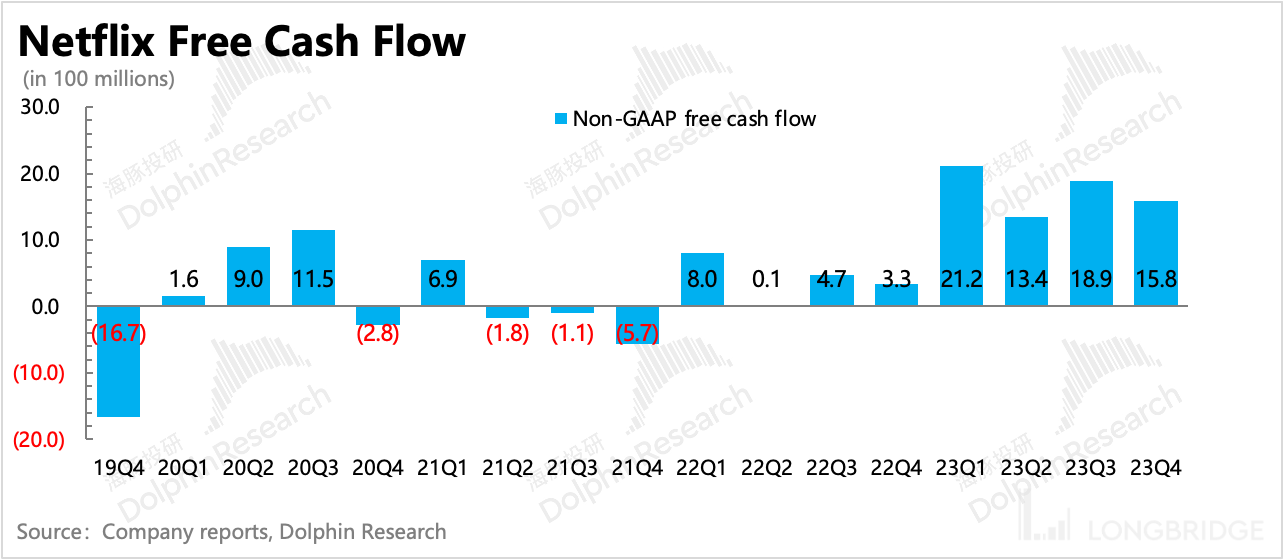
 Likes Received
Likes Received Posts
PostsNetflix: The content giant has a solid foundation and is not afraid of any challenges.

Netflix released its Q4 2023 earnings report in the early morning of January 24th, Beijing time. The fourth quarter saw explosive user growth, driven by a combination of factors including intensified efforts to combat account sharing and promote advertising packages, a shortage of content from competitors due to strikes, and the peak season for Netflix's own content. These multiple positive factors led to a quarterly increase of 13.12 million subscribers, second only to the super dividend period in Q1 2020 when the pandemic first hit.
In addition, profitability exceeded market expectations. Despite the staggered impact of investment and output caused by strikes, the new users attracted through the crackdown on account sharing and advertising packages were able to be retained steadily. This is fundamentally related to Netflix's larger historical content library compared to its competitors, which has always been its core competitive advantage.
Looking ahead to 2024, in addition to continuing to invest in TV series and film content, the company will also focus on betting on content areas such as sports, live shows, and gaming. In terms of business models, expanding the user base through advertising packages is expected to provide strong support to total revenue, although advertising revenue still accounts for a small proportion. The company expects advertising revenue to contribute significantly to total revenue by 2025.
Furthermore, with multiple monetization methods, the company has set higher profit margin targets. It is expected that the operating profit margin will increase from 22%-23% to 24% in 2024.
Specifically:
1."Second highest quarterly user growth in history"
In Q4, Netflix added a net increase of 13.12 million subscribers, significantly exceeding the company's guidance (similar to the net increase of 8.76 million in Q3). Although third-party platform statistics on app downloads have already shown strong user growth, the actual growth situation once again exceeded market expectations due to Netflix's strategies of cracking down on account sharing and promoting advertising packages.
No specific user guidance has been given for Q1 2024, but management estimates a seasonal decline (below Q4 23), but it will definitely be higher than the same period last year (+1.75 million in 1Q23). The current market expectation is around 4.3 million, and Dolphin Research believes that based on the continuation of content popularity from Q4 and the promotion of cracking down on account sharing and advertising packages, overall performance is likely to exceed expectations.
2.Price increases have not yet had an impact, advertising is a strategic focus this year
The introduction of advertising packages and the crackdown on account sharing will have a more significant user-driven effect in developing countries where price sensitivity is higher but ARPU is lower, thereby indirectly lowering the overall ARPU level.Although there was a price increase in October for the US, UK, and France, it seems that it did not have an impact on user growth. This may be due to the short duration of the price increase (only 1 month) and the relative advantage of the content during the same period. Whether the price increase will affect the purchasing power of existing users and whether there is still room for further price increases can be observed for another quarter.
However, the company mentioned that it will continue to aggressively promote its advertising plans this year, including canceling basic plans in more mature regions. Therefore, overall ARPU will be under short-term pressure until advertising monetization reaches a significant scale.
3.Accelerated improvement in revenue, double-digit growth this year
The significant growth in users and a slight YoY decrease in ARPU offset each other, resulting in a 12.5% YoY growth in total revenue for Netflix in the fourth quarter, slightly exceeding expectations. The company's revenue forecast for the first quarter of this year is 9.24 billion, with a YoY growth rate of 13%, slightly accelerating compared to the fourth quarter.
Strategically, Netflix hopes that advertising revenue will become a strong support for the company's revenue generation in the future. Market expectations are that Netflix's advertising revenue will only account for 2% of total revenue in 2023. Compared to Hulu's 36% and Spotify's 13%, Netflix still has significant room for growth in its advertising business.
4.The improvement in profitability is the essence of competitive advantage
Netflix achieved an operating profit of 1.496 billion in the fourth quarter, a significant increase of 172% YoY. However, this includes factors such as misalignment of input and output due to the impact of strikes (reduced content scheduling, decreased amortization costs).
But the fact that Netflix can attract new users and retain them to achieve accelerated revenue growth even with fewer content offerings compared to previous years is a testament to its historical content library advantage.
After raising the profit target for the previous quarter and having confidence in the content reserves for 2024, the management has once again raised the profit margin target for this quarter from 22% to 23% to 24%.
5.Returning to the content investment cycle this year
Last quarter, due to the impact of strikes, some content investments were temporarily halted, resulting in a decline in content spending and a decrease in the size of content assets. However, there have been some changes in the fourth quarter.
Although the strike ended in November, the downward trend in content investment in the fourth quarter has significantly slowed compared to the previous three quarters, and the spending has increased in absolute terms. The company stated that the impact of the strike on content investment was a delay of approximately 1 billion in spending, and with the increase in personnel costs after the strike, it is expected that content amortization will return to single-digit growth this year, and content investment will recover from 14 billion in 2023 to 17 billion.
In the fourth quarter, the company had a free cash flow of 1.58 billion, exceeding the target of 6.5 billion that was already raised in the previous quarter. The company repurchased 5.5 million shares in the fourth quarter, consuming 2.5 billion in funds, which is consistent with the level of repurchases in the third quarter. As of the end of the fourth quarter, there is still 8.4 billion of the approved 10 billion repurchase amount from September.
Dolphin Research's Perspective
Another explosive quarter of user growth. The situation in these two quarters fully demonstrates Netflix's competitive edge in content - a large quantity with high quality. When the new content reserves are also affected by occasional events, Netflix's historical content library can amplify its competitive advantage.
On the other hand, the effectiveness of cracking down on account sharing and advertising packages has exceeded expectations, which also indicates the growth potential and room for imagination in the industry.
Currently, Netflix has overcome the disruptions caused by strikes and returned to its normal content investment cycle. Early investment leads to early harvest. While traditional film and television giants are still stuck in the decline of traditional channels, Netflix has a great hope of maintaining its industry advantage at least until 2024.
In terms of valuation, based on the post-market rally, the current market value corresponds to a PE ratio of 28 times in 2024. The average compound annual growth rate of profits in the next three years is expected to remain at around 18%. Therefore, the overall valuation is still in the neutral to high range. It is not difficult to stabilize the valuation in the short term when the fundamentals are favorable, but it is necessary to pay attention to the risk of marginal weakening when the competition gradually recovers in the second half of the year.

The following is the detailed content:
1. "The second-highest" single-quarter user growth
In the fourth quarter, there was a net increase of 13.12 million subscribers, exceeding the market's expectation of 8.9 million. The increase in users still stems from the measures taken by Netflix this year to crack down on account sharing in more than 100 countries worldwide, as well as the more effective advertising packages in emerging markets.
In terms of regions, user growth in all four major regions exceeded expectations. Contrary to previous perceptions, this time the growth was driven by Europe and the United States, with North America and Europe adding 2.81 million and 5.1 million subscribers respectively. Dolphin Research believes that in addition to the effect of cracking down on account sharing, it is also related to Netflix gradually canceling the basic package and expanding the coverage of advertising packages in mature regions such as the United States and the United Kingdom since July.
The promotion of advertising packages began at the end of 2022, reaching 5 million in May and 15 million in November. It was recently announced that it has reached 23 million. According to third-party data, among the newly registered users in the United States, 30% have chosen the advertising package.



For the first quarter of 2024, the company has not provided specific user guidance, but has given a rough estimate - the seasonality will be lower than the fourth quarter (13.12 million), but higher than the first quarter of 2023 (1.75 million).
Dolphin Research believes that although the first quarter is generally a slow season for Netflix, some series were released late in the fourth quarter, so it is expected that the momentum will continue into the first quarter. In addition, based on the current content schedule of competitors and Netflix's promotion of advertising packages (plans to continue canceling basic subscription packages in some regions), it is not difficult to exceed expectations overall.
With two consecutive user growth exceeding expectations, the market may temporarily reduce concerns about the prospects of video streaming platforms. Especially in the case of price increases in core regions such as the United States, the United Kingdom, and France in the fourth quarter, and the growth level comparable to the pandemic bonus period in 2020, it shows that Netflix, and even the entire streaming media industry, still has a lot of room for penetration and gradually replacing traditional channels.

As of the end of 2023, Netflix's total number of users exceeded 260 million, but the management once again emphasized the medium- to long-term goal of reaching 500 million users (excluding China and Russia). They believe that Netflix's TV viewing share in various regions is still less than 10% and is expected to further replace traditional channels in the future.

Dolphin Research believes that the user expansion in the second half of 2023 was also stimulated by some external factors, including the pressure on competitors to reduce costs and increase efficiency, as well as the impact of strikes on the content libraries of competitors, which helped slow down the competition. Therefore, when industry competition resumes, Netflix's user growth may not be as easy as it is now. Reaching 500 million users is still a long and arduous task.
2. Price increase has not yet shown any impact, and advertising is a strategic focus this year.
In the fourth quarter, Netflix achieved a total revenue of $8.83 billion, a year-on-year increase of 12.5%, and a further acceleration on a quarterly basis.
In terms of business segments, streaming revenue (subscriptions + advertising) reached $8.83 billion, a year-on-year increase of 12.8%, mainly driven by user growth. The DVD business has been reduced to zero this quarter after the company announced its complete closure at the end of the third quarter.
After the last quarter's earnings report was released, the company immediately raised prices in the United States, the United Kingdom, and France. Although it has not been long since the price increase, there seems to be no impact on user growth, so we can continue to observe the situation in the next quarter. In most other regions, they are still within the impact period of price reductions at the beginning of the year, coupled with the relatively low prices of advertising packages themselves. Therefore, except for the continued growth of ARPU (average revenue per user) in the United States, the MoM in other regions has declined.


Strategically, Netflix hopes that advertising revenue will become a strong source of revenue for the company in the future. Currently, advertising revenue is still very small, with market expectations of only around 500 million in 2023, accounting for only 2% of total revenue. If we look at the business structure of streaming media platforms such as Hulu and Spotify (with advertising revenue accounting for 36% and 13% respectively), Netflix's advertising revenue still has the potential to contribute a significant share of revenue in the future.
The monetization ability of advertising is highly correlated with traffic. As of the beginning of this year, Netflix had just reached 23 million advertising users, and most of them are non-US users. This is not only lower than its peers, such as Disney with 50 million, but also significantly lower than YouTube (2 billion), TikTok (1.5 billion), and Instagram Reels (2 billion). Therefore, expanding the scale of advertising users is a key strategic focus for the company.
This also means that until advertising monetization reaches a certain scale, Netflix's user ARPU in non-price increase regions or in areas where advertising users are the main focus is likely to further decrease. If during this period, competitors regain their competitiveness and affect user growth, it may also have an impact on the company's performance, especially its profitability.
So when will competition among peers return to being intense?
3. Short-term dividend of competition slowdown
Competition in the streaming media industry has always existed, but last year Netflix mainly enjoyed two waves of "special dividends" from the slowdown in competition:
(1) Decline of traditional media, peers reducing investment
Many of Netflix's peers are traditional film and television media companies. The decline of cable TV business has left these peers with their own problems, and in order to stabilize their performance, they can only open up external licensing (such as Disney and Warner) or seek alliances (such as Paramount and Showtime).
Whether it is the former or the latter, the same action is to slow down investment in original content, which undoubtedly reduces the investment pressure on Netflix. As the largest film and television streaming platform, Netflix can take over the content licensing of these traditional film and television companies and enrich its own content library.
(2) Hollywood strike leading to production stagnation
The strike, which lasted nearly six months, caused a shortage of content in the libraries of Netflix's peers. Although Netflix was also affected, it benefited relatively due to its position as the industry's leading film and television content library.
But how long can these dividends last?Dolphin Research believes that in the short term, at least until the first half of this year, Netflix can still continue to benefit from the slowdown in competition. Especially with the impact of strikes, according to the normal production cycle, it will last for at least another six months. The pressure to reduce costs and increase efficiency in the industry may also require waiting until the second half of the year when the high-interest environment significantly weakens before seeing a strategic shift.
According to Nielsen's data, after Netflix started sharing restrictions in May, the platform's viewership share reached a new level and has remained relatively stable. It declined to 7.2% in September and October, possibly due to the launch of multiple sports events (Netflix and even streaming platforms do not have a competitive advantage in sports content). However, starting in November, Netflix returned to the peak season cycle, and its viewership share continued to climb to 7.7%.
On the other hand, YouTube, its old rival, declined by 0.5 percentage points from 9%.

In the medium to long term, although Netflix can continue to benefit from the decline of traditional channels, it also needs to stay vigilant against the "comeback" of its competitors, including Big Tech rivals (such as Amazon) that continue to make aggressive investments, as well as cross-industry competition. Since Netflix has introduced an advertising business model, in order to ensure effective revenue generation, from the perspective of duration, it also needs to compete with YouTube, as well as short video platforms TikTok and Instagram Reels. Among the young user groups who are enthusiastic about trendy and user-generated content, Netflix may face greater competitive pressure.
Although Netflix announced at the beginning of the year that its advertising layer users reached 23 million, in November last year, after raising prices in core mature regions, Netflix launched the "watch three episodes, skip one episode of ads" campaign for other regions, intending to quickly expand its advertising layer user base in the short term.
Considering the complaints from some advertisers about insufficient exposure of Netflix ads, the actual effectiveness of Netflix's advertising layer should be discounted, and the 23 million users may be mainly from developing countries outside the United States. This is somewhat different from the demands of advertisers, so Netflix needs to provide more incentives to attract advertising layer users.
In the shareholder letter for the fourth quarter, management also devoted a considerable amount of space to discussing competition. However, management is not worried about the competitive strength of traditional content companies because these companies are still trapped in the decline of traditional channels. However, they are highly concerned about the streaming platforms of technology companies, short video platforms, and social media platforms with video content.
4. Strike Disturbance Does Not Change Content Investment in a New Cycle
Dolphin Research has consistently mentioned in its analysis reports over the past few quarters that Netflix's content amortization has been increasing, but its content investment has been declining rapidly. When the scale of content assets turned negative on a quarter-on-quarter basis last quarter, it indicated that Netflix's content investment may have hit bottom and rebounded.
Last quarter, due to the impact of strikes, some content investments were temporarily halted, resulting in an accelerated decline in content expenditure and a quarter-on-quarter decrease in the scale of content assets. However, there have been some changes in the fourth quarter.
Although the strike ended in November, the downward trend in content investment in the fourth quarter has significantly slowed down compared to the previous three quarters, and the expenditure has increased on an absolute basis. The company stated that the impact of the strike on content investment was approximately 1 billion in delayed expenditure, and with the rise in personnel costs after the strike, it is expected that content investment will return to growth this year, reaching a budget of 17 billion.
However, there is still some time from content production to release, and Netflix may have made short-term adjustments to its programming schedule. As a result, content amortization in the fourth quarter decreased by 5% compared to previous years, and the scale of content assets remained relatively stable on a quarter-on-quarter basis.



In other words, the strike also had an impact on Netflix's content supply for several quarters, but compared to its peers, Netflix has a stronger foundation in terms of content library, which can meet the demand for user viewing affected by crackdowns on account sharing and advertising diversion. This is the core key to Netflix's ability to maintain a relative advantage in the industry.
Early investment leads to early harvest. As Dolphin Research mentioned last quarter, although some investors in the market are cautious about the impact of increased investment on profitability, we should take a positive view of entering a new cycle of content investment from a long-term perspective. The current investment is for the future 1-2 years of content reserves, and as long as the content reserves are abundant, the competitive position will be more solid.
Based on the current pipeline, the first quarter is a low season for content, but starting from the second quarter, there will be the release of highly-rated sequels such as "Bridgerton S3," "Squid Game S2," and "Empress S2." The management also expressed confidence in the content reserves for 2024 in the shareholder letter. Dolphin Research believes that at least for most of this year, Netflix still maintains a relatively comfortable position in terms of content advantage.

5. Content Advantage Drives Profit Potential
In the fourth quarter, Netflix achieved an operating profit of 1.496 billion, a significant increase of 172% YoY. However, this figure includes factors such as misalignment of input and output due to strikes (reduced content scheduling, decreased amortization costs).
But as Dolphin Research mentioned before, the ability to attract new users and retain them to achieve accelerated revenue growth, even with fewer content offerings compared to previous years, is a testament to Netflix's historical content library advantage.
In terms of expenses, apart from a 10% increase in marketing expenses for promoting advertising packages to acquire customers, there were no significant changes.
The final operating profit margin has increased by nearly 10 percentage points compared to previous years, reaching 16.9%. The operating profit margin for the full year of 2023 is 20.6%. The overall expansion of both advertising package users and paid package users implies an improved monetization capability for the same content.
Content advantage brings competitive advantage, and competitive advantage brings higher profitability. With confidence in the content reserve for 2024, the management has raised the original operating profit margin target for 2024 from 22% to 23%, and then further increased it to 24%. This undoubtedly brings great investment confidence to the market.

Improved profitability naturally leads to healthier cash flow. In the fourth quarter, Netflix had a free cash flow of 1.58 billion, and achieved a net cash inflow of 6.9 billion for the full year, higher than the updated target of 6.5 billion for the previous quarter.
With sufficient cash, there is more room to pay off debts, repurchase shares, continue to invest, and make acquisitions. In the fourth quarter, Netflix significantly increased its share repurchase efforts, repurchasing 550 million shares for 2.5 billion US dollars. The 100 billion US dollar repurchase plan announced in September still has 8.4 billion in repurchase capacity. If the repurchase efforts continue at 25 billion per quarter and 100 billion per year, shareholders can expect at least a 4-5% return benefit on repurchases.

Dolphin Research "Netflix" Historical Articles
Earnings Season
October 19, 2023 Conference Call: "[Netflix: Hoping to Restore Investment Levels to Drive Growth (3Q23 Earnings Conference Summary)](https://longportapp.com/zh-CN/topics/10294408?Earnings Report Commentary on October 19, 2023: "Growth questioned? Netflix fights back with price increase"
Telephone Conference on July 20, 2023: "The impact of cracking down on account sharing will be further demonstrated (Netflix 3Q23 earnings conference call summary)"
Earnings Report Commentary on July 20, 2023: "Netflix: Squeezed user growth, market not buying it?"
Telephone Conference on April 19, 2023: "Focused on the prospects of advertising and account sharing for payment (Netflix 1Q23 conference call summary)"
Earnings Report Commentary on April 19, 2023: "Freeloaders are hard to beat, Netflix 'flies' but can't move"
Telephone Conference on January 20, 2023: "Senior management changes do not hinder content strategy, advertising revenue target is above 10% (Netflix 4Q22 conference call summary)"
Earnings Report Commentary on January 20, 2023: "Hit drama saves advertising, Netflix perfectly interprets 'content is king'"
Telephone Conference on October 19, 2022: "Netflix: In addition to advertising, next year will focus on cracking down on account sharing (3Q22 conference call summary)"
Earnings Report Commentary on October 19, 2022: "Netflix: Soaring against the trend, good content is the real 'cure'"
Telephone Conference on July 20, 2022: "The advertising model is the new story of Netflix's future (conference summary)"Earnings Report Commentary on July 20, 2022: "Netflix: No Thunder, No Need for Carnival"
Telephone Conference on April 20, 2022: "Focus on How to Increase Revenue, Lack of Confidence in User Growth Exposed (Netflix Conference Call Summary)"
Earnings Report Commentary on April 20, 2022: "A 25% Overnight Plunge, Netflix's Logic Collapses"
Telephone Conference on January 21, 2022: "Management Says Guidance Gap Due to Forecast Uncertainty Caused by the Pandemic (Netflix Q4 Earnings Conference Call Summary)"
Earnings Report Commentary on January 21, 2022: "A 20% Plunge? Netflix Becomes a Copycat of iQiyi"
Telephone Conference on October 20, 2021: "Ambitious Netflix's Next Goal is to Learn from Disney (Q3 Conference Call Summary)"
Earnings Report Commentary on October 20, 2021: "Netflix: The Return of the Streaming Media Giant, Accident or Destiny?"
Telephone Conference on July 21, 2021: "Netflix Q2 Conference Call Summary"
Earnings Report Commentary on July 21, 2021: "Continued Conservative Guidance, When Will the King of Netflix Return in the Post-Pandemic Era? | Dolphin Research"
Telephone Conference on April 21, 2021: "Netflix Q1 Conference Call Q&A: Take a Look at Management's Answers to User Growth Questions"
Earnings Report Commentary on April 21, 2021: "After the End of the Pandemic Dividend, Netflix's User Growth Takes a Hit"In-depth Analysis
On February 16, 2022, Dolphin Research published an in-depth analysis titled "The Battle of Consumer Internet Giants: Meta, Google, Netflix Competing Head-on".
On November 23, 2021, Dolphin Research published an in-depth analysis titled "The Coming Battle in Long-form Videos: A US Version, Netflix and Disney in Trouble?".
Please refer to the risk disclosure and disclaimer in this article: Dolphin Research Disclaimer and General Disclosure.
The copyright of this article belongs to the original author/organization.
The views expressed herein are solely those of the author and do not reflect the stance of the platform. The content is intended for investment reference purposes only and shall not be considered as investment advice. Please contact us if you have any questions or suggestions regarding the content services provided by the platform.

